Islas Palomino: Boat trip in Callao
Just off the coast of Callao, or more precisely, about 4km from the tip of La Punta, are two rocky uninhabited islands, which together with a few other rocky outcrops are called the Islas Palomino. The two major islands, one large and one small, are called San Lorenzo and El Frontón. Each have their own stories to tell.
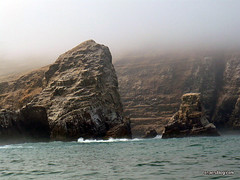
Islands in the mist
Taking the boat trip around the islands is one touristy thing I have never got around to doing, but something I had wanted to do for a long time. So with an afternoon to spare while we were in Callao, we decided to do it. After parting with the 40 soles per person it costs for the trip that lasts a couple of hours, we waited at the docks of old Colonial Callao for our boat to come in. In true Peruvian style it arrived 40 minutes later than it should have, but we and a few dozen Peruvian families were quickly allowed to board and we left without any further delay.
It was a clear day. Callao was free of the sea fog that usually plagues it. I’m not really sure if the trip would be worth doing during the midst of the coastal winter when you often can’t see more than a few dozen metres away. I’d definitely recommend doing it in the summer instead.
As the large ferry we were on skimmed across the water, we passed around the sailing boats along the north side of La Punta before passing the tip of the peninsula and heading out towards the islands. As we did, we also passed a scientific vessel called the Humboldt, that studies the Pacific ocean current of the same name.
The Humboldt current, running from Antarctica up the western coast of South America, is rich with life. Looking out into the dark ocean we could see this was true. Not only were the waters dark with nutrients, but there were huge numbers of very large jellyfish close to the surface. Some were white, some where red, but all had a main body about half a metre in diameter and tentacles stretching out at least another metre. I couldn’t help but wonder how many of them were getting churned up by the boat’s motors.
El Frontón

The famous jail
We slowly approached the first of the two islands – the smaller called El Frontón with a landmass of just 1km2. It was here that pirates once docked, out of range of colonial Callao’s cannons, but within striking distance. Much later, in 1917, President José Pardo ordered the construction of the prison for which the island is now famous.
The prison of El Frontón was originally meant to hold ordinary dangerous criminals, but it was during the mid-80s that its purpose was changed somewhat. Maoist terrorists called the Shining Path waged war on the Peruvian Government killing tens of thousands of innocent civilians in the process. Then-President Alan García, a man who proved incapable of running the economy or winning the war, ordered that captured Shining Path soldiers be sent to isolated El Frontón.
On the 18th of June, 1986, all went to hell. Terrorists imprisoned there, who were nothing less that hardened soldiers, were able to take control of the prison, taking prison guards hostage. Garcia ordered the Navy, who’s naval base was just minutes away, to retake the island by force. After the successful operation, it was clear that a significant number of the terrorists had been killed in the action, with the majority appearing to have been extra judicially executed. Alan Garcia suppressed investigation of the incident, until later fleeing the country that was collapsing around him for fear of being prosecuted for it, or prosecuted for the deaths of civilians in the war against the terrorists, or perhaps prosecution for driving the country into complete economic ruin. He remained out of the country, living in Colombia and France on vast sums of money obtained from unknown sources, until the legal time limit passed for investigations to be carried out, while his corrupt APRA party hindered any investigation.
Guano, Sea Lions, Penguins and San Lorenzo
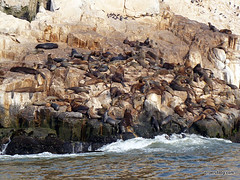
Rich wildlife
Passing El Frontón we continued around to the back of the islands. The mainland was no longer visible. We found ourselves between smaller rocky islands and the island of San Lorenzo. It is here, hidden from mankind and our colonies of concrete that we find the refuges of nature.
But there are still signs of our interference. Out on one of the small islands we see an old dock. It was here, a century ago, that there was a small but booming guano industry. Birds had coated these rocks over the centuries with their droppings which, nutrient rich, could fertilise our fields and improve our harvests. It was only when artificial fertilisers were invented that the practice, and the guano economic boom, died out.
These rocks are now home to a sea lion colony. The huge beasts are so unafraid that the boat is able to go right up to the rocks without them taking any notice of it. The stench is strong, but it is a great experience to see these while creatures up close. The males fight over the best positions on the rocks – the largest bathe in the sun higher up, while the smallest sit uncomfortably on the waterline, getting washed back into the sea by large waves.
We head back over to San Lorenzo where we meet the Pacific coast’s most famous resident – the Humboldt Penguin. It’s only because of the life-giving Humboldt Current the these penguins are able to live in the coastal deserts of Peru and Chile. The current also brings north water that is cool enough for these penguin, allowing them to live in what is actually the earth’s tropical zone.
Far more shy, we watch the penguins from a greater distance away. But there are hundreds and hundreds of them, all squawking away amongst themselves, some jumping into the water, others jumping out.
As the air cools, the mist rolls in, and the sun begins to fall, the boat heads back to the docks. Passing around the other side of San Lorenzo, the jellyfish are here too. We arrive back safely and satisfied.
Tags: callao, el fronton, explorando lima, garcia, guano, humboldt, humboldt penguin, isla san lorenzo, islas palomino, navy, penal, penguins, sea lions, shining path



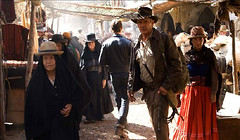
![Lima’s sewage pollutes the ocean [Featured]](http://sp8.fotolog.com/photo/8/40/95/chriztian_bhare/1213163180876_f.jpg)
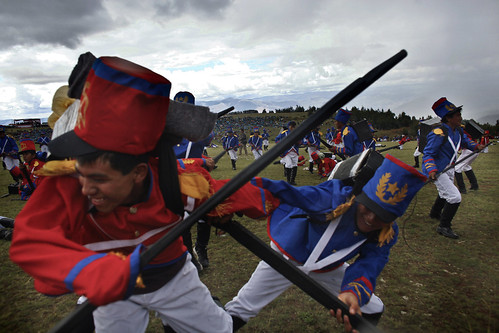
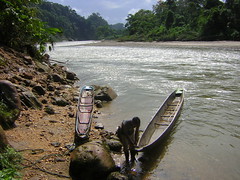
![A Peruvian’s view on the problem of corruption [Featured]](http://farm4.static.flickr.com/3142/2893338595_55ba4bdb3e_m.jpg)
